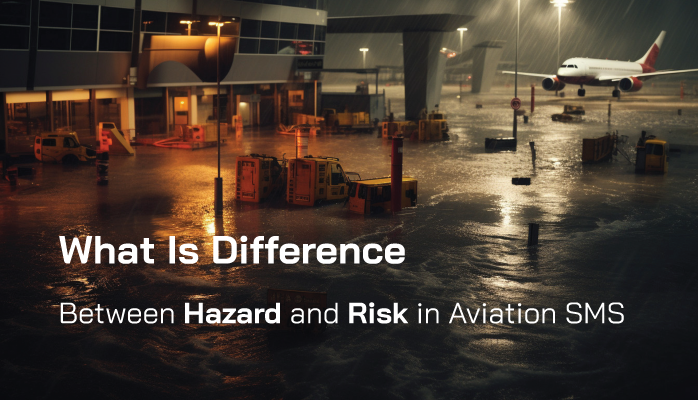I Thought I Knew the Difference Between Hazard and Risk

Quickly, look at the picture at the right.
What is the "hazard?"
What is the "risk?"
I consider myself well-educated with a college education.
I understand English, as it is my first language.
Before I was dragged into the aviation safety management system world in early 2007, I really never considered hazards and risks very deeply. Back in my pre-SMS days, electrical hazard and electrical risk were synonymous.
Related Aviation Hazard Articles
- Relationship Between a Hazard and Risk Occurrence in Safety Management
- How to Identify Hazards and Assess Risks in Aviation SMS – With Free Resources
- 5 Tips Reviewing Hazards, Risks & Controls in Aviation SMS - With Examples
This morning, I was asked for a simple explanation about "hazard" and "risk." You may find this interesting if you are an aviation safety professional.
Sometimes I Feel Ignorant... but My Friends Are Patient
By now, most who read this blog know that I work on developing and supporting SMS Pro, which has grown to become a world-class aviation SMS database. I'm not here to promote the product. I'm really proud to hear independent consultants and SMS software evaluators tell us that SMS database software is the best on the market.
A lot of work went into this SMS software and in order to develop an effective product, the software engineers must know the subject matter better than the end users. After a while, we become subject-matter experts. Sometimes we are right, and many times we are wrong.
Case in point: in the first version of the proactive hazard analysis tool (we call it PHAT internally), I learned that I didn't know the difference between hazard and risk in the sense that aviation safety professionals understand hazard and risk. Needless to say, I was embarrassed when I provided a demo of version #1 to a safety manager.
It was clear to the safety manager I didn't know what in the hell I was talking about, but the safety manager was patient and steered me on the right path.
So don't feel bad if you don't really understand what is the difference between a hazard and risk. Just be willing to learn.
Why Is It Important to Know the Definition of Hazard and Risk

For most laypersons, our understanding of hazard and risk is adequate. However, for aviation safety professionals to be effective, we all have to be speaking the same language and completely understand these terms.
Safety managers who have a poor understanding of hazard and risk definitions are less likely to communicate effectively with other safety professionals. Case in point, just look at my early experience that still hurts my pride.
You cannot understand a subject well until you are able to teach it well to others. This is such a very true fact of life. It doesn't matter what the subject matter is. Your subject could be the
- difference between a hazard and risk; or the
- difference between reactive and proactive risk management; or the
- difference between halibut fishing and salmon fishing techniques.
If you are able to teach the subject well, then you should know the subject well. The reasoning is that when a teacher is forced to teach the same content repeatedly, the teacher is probably going to tire of giving "poor performances." After all, a teacher is a performer. If you have never stood in front of a class on a scheduled basis, you may not have considered that the students are sitting back watching "the show." It is very uncomfortable for a teacher to be teaching a subject that he does not know well.
Related Aviation Hazard Identification Training Articles
- 4 Pillars | What Is Hazard Identification in Aviation SMS
- 4 Tips to Approach Hazard Identification in Aviation SMS
- Understanding Role of Hazard Identification Training and Safety Reporting Forms in Aviation SMS
And this will hold true with safety managers and the hazard and risk terms. Safety managers will need to be teaching employees about hazard identification. Hazard identification training is an important element of every successful SMS. Poor hazard identification capabilities in an SMS will reduce your company's ability to effectively monitor operations and identify hazards that potentially affect operations in an undesirable manner.
Employees interact with hazards every day. They need to be trained on
- operational hazards;
- risks related to these identified hazards;
- existing risk controls to detect or mitigate hazard's risk; and
- early warning signs to be alert for should the hazard manifest itself.
Hazard and risk are two elements that routinely jump up into every safety manager and department head's face, whether they are:
- Treating issues by managing corrective preventive actions (CPAs);
- Communicating hazard and risk in safety newsletters;
- Evaluating control measures; or
- Drafting risk statements when new issues are reported.
What Is a Hazard in Aviation SMS?
Hazard is an element or condition in your environment. There are many definitions, but I like the third hazard definition from Skybrary.
A hazard is any existing or potential condition that can lead to injury, illness, or death to people; damage to or loss of a system, equipment, or property; or damage to the environment.
Hazards may be classified:
- Physical (mountains, obstacles);
- Human behaviors;
- Political;
- Environmental (weather);
- Legal; or
- Technological.
Related Aviation Hazard Identification Training Articles
- How to Be Compliant With ICAO Hazard Identification
- From Reactive to Proactive Hazard Identification in Aviation SMS
- Safety Chart: Where to Focus Hazard Identification
What Is a Risk in Aviation SMS?
The risk is what may happen should a hazard manifest itself, that is, what may happen if your operations interact with any particular obstacle.
How to Reduce Confusion Between Hazard and Risk
Here is an example I always use in my head to keep the two straight:
A mountain is a hazard;
Running into the mountain and causing mission failure is the risk.

We can then go into control measures (risk controls) and strategies to mitigate risk. Actually, control measures can be of two main types:
- Mitigation measures; and
- Recovery measures.
Mitigation measures help to:
- Keep the hazard from manifesting itself;
- Fix the damage, should an event occur; or
- Control the damage should an event occur.
Recovery measures are corrective/preventive actions that are implemented to "recover" from an event. Recovery measures should be designed to get back to operational normality as soon as possible.
Control measures should follow a well-defined hierarchy of controls:
- Elimination;
- Substitution;
- Administrative;
- Engineering; and
- Personal Protective Equipment (PPE).
This topic is expanded upon in another article below. I am hoping that my technique to keep hazards and risks is useful to someone.
Related Aviation Hazard Articles
- Difference Between Hazards, Risks & Control Measures in Aviation SMS
- How to Identify Hazards in Aviation SMS
- Winter Fatigue Hazard Register Review - Aviation SMS SRM & SA Example
Final Words on Hazard and Risk in Aviation SMS
It is important that aviation safety professionals speak the same language. Hazard and risk are two very basic words that we use daily. If you still have confusion, remember:
A mountain is a hazard;
Running into the mountain and causing mission failure is the risk.
In the case of a volcano image, the hazard is the volcano emitting ash.
The risk is damage to aircraft resulting in possible mission failure and possibly worse.
You may be interested in seeing an informative demo of how hazards and risks are treated in aviation SMS database software. The Proactive Hazard Analysis Tool is very sweet, as well as the resulting hazard register that is generated from the PHAT. These tools save safety managers and department heads considerable time.
Last updated in November 2024.







